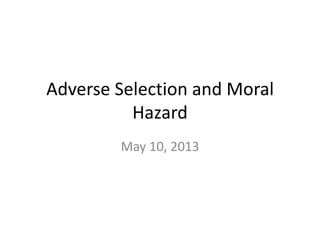
051013
- 1. Adverse Selection and Moral Hazard May 10, 2013
- 2. Announcements • If you haven’t gotten exam back – it’s now with economics undergrad office • Remember: homework due Monday morning! • Class next Friday cancelled for Sun God.
- 3. Last Class • Roles of information: – show-rooming – search / gambles – asymmetric information & lemons
- 4. Learning Goals for Today • Describe the two features of a credible signal. • List many types of statistical discrimination. • Compare and contrast adverse selection and moral hazard.
- 5. How Do You Credibly Signal Quality? • The lemons problem we just looked at could have been avoided if the owners of good cars could have credibly signaled their quality. • How do you credibly signal quality? • In other words, what must be true about the signal itself for it to be credible?
- 6. How Do You Credibly Signal Quality? • The lemons problem we just looked at could have been avoided if the owners of good cars could have credibly signaled their quality. • How do you credibly signal quality? Signal Must be Costly Signal cost lower when quality high ``costly to fake’’ ``not costly if truthful’’
- 7. Examples 1. How can people selling cars signal that their cars are high quality? – Offer warranty. – Costly, but less costly (on average) for people with good cars. 2. How can workers signal to employers that they are highly motivated? – High college GPA – Costly, but less costly for highly motivated people.
- 8. Examples 3. How can sellers of any product signal that their product is high quality? – Expensive advertising – Costly, but less costly for good products that generate repeat sales. 4. How do real estate agents signal their ability to potential clients? – Drive a nice car – Costly, but less costly for successful (higher earning) agents.
- 9. Being seen driving an expensive car is a good way for which professional to signal their abilities? A. carpenter B. realtor C. political officeholder D. major league baseball player E. there is more than one answer
- 10. Statistical Discrimination • Statistical discrimination: the practice of making judgments about the quality of people, goods and services based on the groups to which they belong. • In the presence of imperfect information, economic agents will have an incentive to statistically discriminate. • Examples
- 11. Which of the following is a solution to statistical discrimination in hiring? A. a minimum wage B. punishing workers who are consistently late C. federal guarantees for maternity leave D. not hiring college grads with low grades
- 12. Adverse Selection • Adverse selection: the pattern in which insurance tends to be purchased by those who are most costly for companies to insure. • Any situation in which informed buyers (or sellers) make purchasing (or sales) decisions based on their unobservable characteristics in a way that negatively affects those who are less uninformed . • Leads to inefficient outcomes—markets can “unravel”.
- 13. Moral Hazard • Moral hazard: the tendency for people to expend less effort protecting those goods that are insured against damage or theft? • Can increase the cost of insuring people—if it’s bad enough, moral hazard could make it impossible for companies to profitably insure people. 13
- 14. Clark just bought a new car and was required by state law to purchase full insurance coverage. The moral hazard problem suggests Clark will A. usually try to find a save place to park his car to avoid break-ins B. be careful to lock his car always C. drive carefully in traffic D. park his car in his garage during bad weather E. park outside regardless
- 15. In addition to mandatory insurance coverage, Clark purchases a supplementary plan. Compared to the rate for the mandatory plan, he probably pays A. more B. about the same given he is a male C. about the same given he is over 30 years old D. about the same given he shows his clean driving record
- 16. How Do Adverse Selection and Moral Hazard Affect the Insurance Market? • Insurance companies typically offer a menu of insurance prices. – (a) High deductible, low premium: You cover first $1000 in damages and pay $30 per month. – (b) Low deductible, high premium: You cover first $500 in damages and pay $50 per month. • The deductible helps alleviate moral hazard. • The price structure helps alleviate adverse selection by enabling the insurance company to distinguish between good (a)and bad (b) drivers.